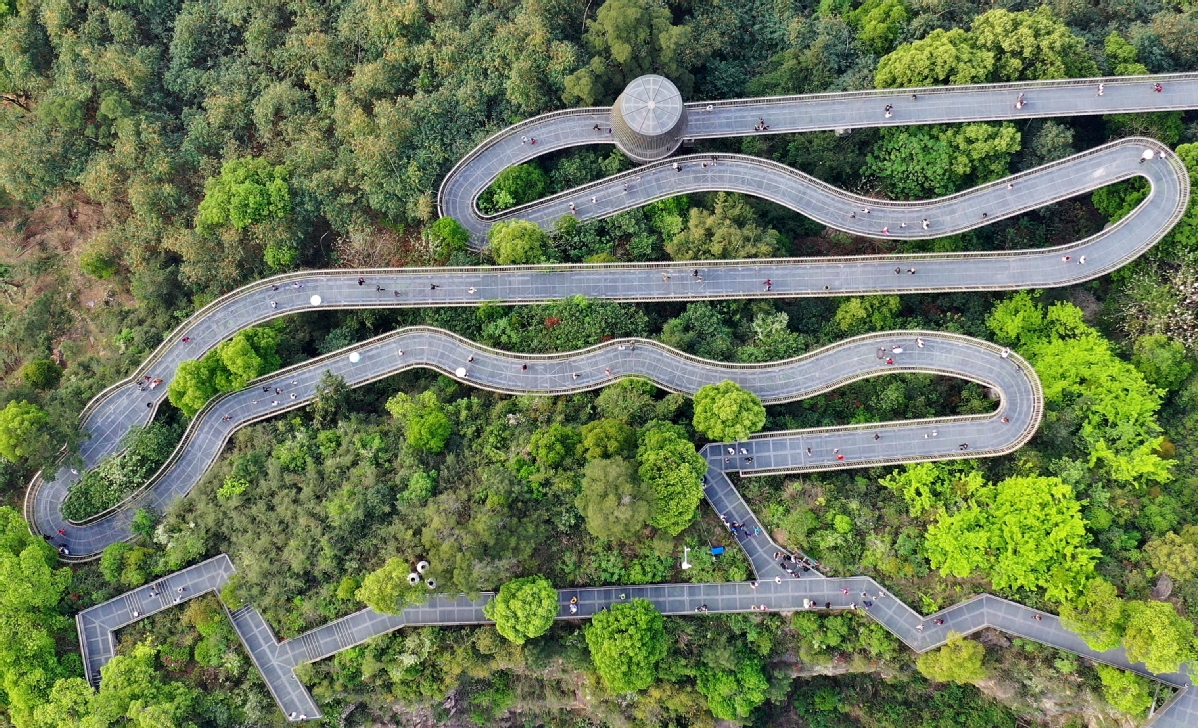Moments in Fujian
Home >> Moments in FujianReporter's log: Why all-go Fujian's journey is as smooth as silk
Source: chinadaily.com.cn | 2021-06-05 17:22 Click:

China Daily reporter Anthony Perry visits the Xindian Ancient Town Relics Park in Fuzhou, East China's Fujian province, May 25, 2021. [Photo/chinadaily.com.cn]
"We want you to go to Fujian."
That's what my boss told me a few weeks ago. So, southern China weather packaged with a celebrated cuisine against the backdrop of forested mountains that meet the sea. That can't be too hard, I thought. I was wrong.
But first, let me tell you about the good parts of a tour themed A Date with China – Meet Fujian. I was traveling with dozens of fellow media workers from China and overseas on a visit that wrapped up a few days ago. We saw gleaming cities whose towers are punching the sky in a testament to their ambitions. But these cities are just as proud of their historical and cultural riches and are keen to share them with visitors.
Our last stop was Quanzhou, the starting point for the Maritime Silk Road that brought the city prosperity in its role shipping the prized commodity to the Middle East– becoming China's busiest port by the 13th century. In the era of the 21st Century Maritime Silk Road – as set out by President Xi Jinping in 2013 alongside his vision for the Silk Road Economic Belt – Quanzhou has hardly skipped a beat in the transition. Its economy reached 1.02 trillion yuan in 2020; and in 1978, it was just 779 million yuan, according to the city's statistics bureau.
The story of inexorable progress is mirrored in Fuzhou, the provincial capital in the east. First impressions count. On the flight from Beijing the lower we dropped on our approach, the deeper and richer it became – the wash of green beyond my window. Low, heavy clouds hovered over the tops of the ranges. Then, as if for my benefit at the opposite end of the plane, the pilot cut a wide arc that opened up a panorama of a green-fringed beach before the aircraft banked sharply – close enough to watch the breakers roll into the shore. My "Meet Fujian" moment came before touchdown.

An aerial view of Fudao, a winding pedestrian greenway in Fuzhou, Fujian province. CHINA DAILY
On the ground, I learned more about Fuzhou's can-do spirit and that of Fujian's other main cities. The province strikes me as a place where the past, the present and the future sit well together. A great trading hub adapts. Once it was silk, and now the products traversing the great transcontinental trade routes are even more plugged into the global economy – like lithium-ion batteries made in Fuzhou. The batteries from Contemporary Amperex Technology power everything from electric scooters to trucks and boats. In the Fuzhou Software Park strides are being made in artificial intelligence and cloud computing. And, since this is Fuzhou, the geeks can seek inspiration along the 20 kilometers of trails set up on the hillsides under an adjoining forest rehabilitation project.

Fishermen fix their fishing nets in Xipi village, Fu'an city, East China's Fujian province, May 26, 2021. [Photo/chinadaily.com.cn]
But it's not just the cities where the gains are being logged. We visited Xipi village, part of Fu'an City, where thousands of boat dwellers have been resettled over the past decades. The project – involving extensive reclamation works – is held up as a showpiece of China's poverty-alleviation efforts. The precarity of life on cramped boats, with up to three generations working and sleeping under a leaky roof, has been swapped for modern conveniences and access to healthcare and education.
Just as the fishing folk of Xipi are enjoying transformed lives, so too are the residents of Chixi village, near the city of Ningde. Residents of Chixi and a dozen nearby hamlets have been resettled into a new village. The inhabitants of the remote mountainous area – mostly members of the She ethnic group – were first targeted for assistance in the 1980s. A museum in Ningde documents their journey from squalor, when no electricity, running water or roads was their lot. As with Xipi, eco-tourism is part of the mix that is building sustainable incomes in Chixi. Visitors now flock to the area for its white tea.

A bird's-eye view of Wuyi Mountain, a UNESCO natural and cultural heritage site in Fujian province. [Photo/Xinhua]
In Wuyishan, it's the rock tea, or yan cha, that helps draw them to an area recognized as a UNESCO World Heritage site. President Xi, on a trip that also took him to Fuzhou, visited a demonstration farm in late March and praised the thriving tea industry's role in helping to lift residents out of poverty.

A photo taken on May 27, 2021, shows the Yanzike tea garden in Wuyi Mountain, Nanping city, East China's Fujian province. [Photo/chinadaily.com.cn]
Now I'll tell you what was so hard about my week in Fujian – it's leaving Fujian. I'm in good company. "It's a place you would never want to leave," Xi told reporters on his March visit to Fuzhou, where he had served as the municipal Party secretary. "I spent the best years of my life here," he added. Reason enough for a return visit.